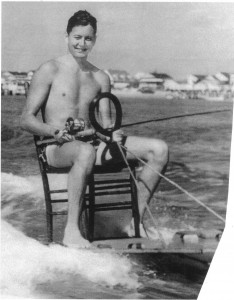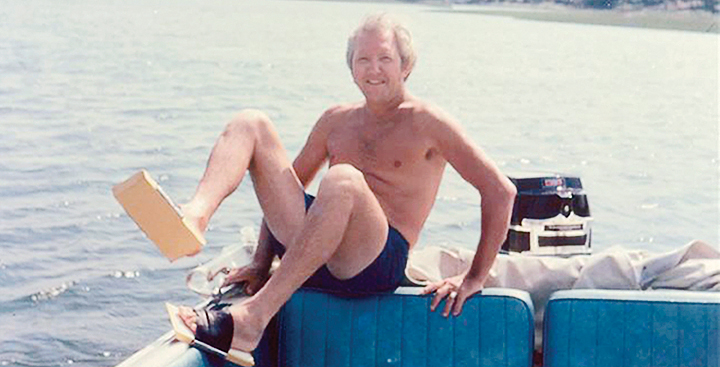
Today, the waters around Wrightsville Beach serve as a playground for paddleboarders and surfers, but in the early 20th century they hosted a different set of activities, from tub racing to barefoot water-skiing to an event called the human fishing contest.
Boat racing was the first watersport to take hold around the island and, over the years, almost any type of craft that floated was raced.
The first Banks Channel yacht races were held in the mid-1800s, when the barren beach strand was still known as Ocean View Beach. Regular organized racing began after the Carolina Yacht Club was founded in 1853.
The Carolina Canoe Club was founded in 1887 and soon canoe races were a common form of entertainment. An 1894 issue of the Wilmington Dispatch described a canoe race in Bradley Creek for watermelon prizes. The melons were lined up on a boat at the finish line and competitors raced to earn the first choice of melon.
Canoes were raced in the ocean, too. Another Dispatch clip from 1912 stated 15 competitors raced through the surf in front of Lumina Pavilion during a Fourth of July celebration. A series of tilting events followed the races, in which two canoes faced off, each manned by two people.
“One of the crew takes a standing position in the bow of the canoe armed with a long pole,” the Dispatch stated. “His object is to dislodge his opponent similarly armed in the other canoe, throwing him into the water. The other man of the crew does the steering.”
Similarly, the island’s bathtub races delivered more entertainment than cutthroat competition. The Wilmington Messenger reported on a Banks Channel tub race from the summer of 1888 in which the winner was the only competitor who managed to keep his tub from overturning.
In the summer of 1910, the Tidewater Power Company, which owned the trolley and a portion of Wrightsville Beach, organized a series of aquatic activities in Banks Channel, the Dispatch reported. In addition to tub and swim races, the event included a human fishing contest.
“It is proposed to have a swimmer play the part of the fish and to have an expert fisherman attempt to land the swimmer,” the Dispatch stated. “A line sufficiently strong will be attached to a cap on the swimmer’s head.”
The fisherman then had 10 minutes to hook and reel in his catch; otherwise the human fish was declared the winner.
During the next few decades, powerboats were introduced to Wrightsville Beach and powerboat racing followed shortly after. The races’ rapid growth in popularity prompted the town to consider an ordinance requiring boat motors be equipped with mufflers. Wrightsville Beach resident Nippy MacDonald remembered watching the Saturday afternoon races from the end of her dock as a child.
“They would race up and down the sound, because we didn’t have all the traffic that you have now,” she said.
As boat owners relished cruising over the water at high speeds, many discovered an even greater thrill: being pulled behind the boat while balancing on skis or other manner of flotation. Phyllis Mallard, who spent summers in the 1940s on the island, remembered water-skiers jumping over a ski ramp built in the channel near the Coast Guard station. The ramp was a part of an aquatic playground of seesaws, slide and swings built in the shallow sound near Wrightsville’s south end.
As balancing on two skis lost its excitement, slalom skiing gained popularity. The progression of the pastime culminated several years later in Thurston Watkins’ stunt on a wooden chair.
“Thurston was an innovator in his own right,” said Ron Phelps, who witnessed the spectacle from the stern of the boat. “Everybody got a kick out of seeing this once-in-a-lifetime event, [Thurston] being pulled down doggone Banks Channel sitting on a chair.”
Over the years, two friends continued attempting daring feats behind Watkin’s 12-foot wooden motorboat. In 1957, Phelps created a pair of 6-inch-long rectangular planks with foot straps and he and Watkins took turns water-skiing on the homemade contraptions.
“Each little wake or little boat that would come by presented a challenge,” he said. “You had to sort of negotiate that over and down and over and down with each foot,” Phelps said.
Luckily, he said, in that carefree era there was less boat traffic and fewer regulations.
“We were young whippersnappers,” he said wistfully. “I would give anything to be able to do it again.”
email [email protected]




